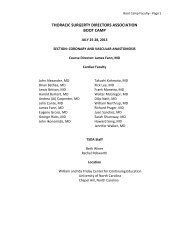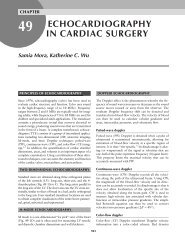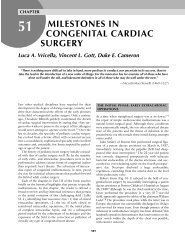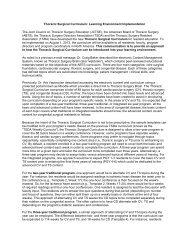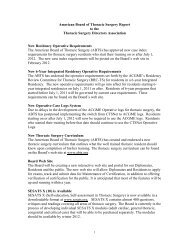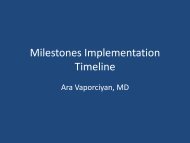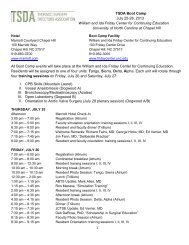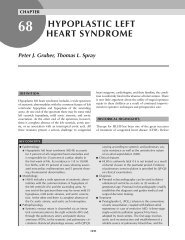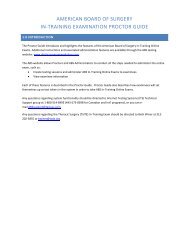Introduction to Cardiopulmonary Bypass - TSDA
Introduction to Cardiopulmonary Bypass - TSDA
Introduction to Cardiopulmonary Bypass - TSDA
Create successful ePaper yourself
Turn your PDF publications into a flip-book with our unique Google optimized e-Paper software.
Why CPB• To facilitate a surgical intervention• Provide a motionless field• Provide a bloodless field
Patient populations• Coronary ArteryDisease (CAD)• Valve Disease• Congenital HeartDefects• Dissections• Aneurysms– aortic, ventricular,giant cerebral• Transplants– heart, liver, lung,trachea• Other– limb cancer,hypothermic rescue
Extracorporeal Circuit• An artificial external blood pathway withartificial organs• 3.5 - 4 M 2 of plastics and metals
Venous Tubing• Minimum 10 mmHg pressure drop• 1/4 inch = 0.9 lpm• 3/8 inch = 4.0 lpm• 1/2 inch = 7.0 lpm
Arterial Tubing• Velocities less than 200 cm/sec result inacceptable hemolysis rates• 1/4 inch = 3.4 lpm maximum flow• 3/8 inch = 7.0 lpm maximum flow
Cannulas• Arterial– Return blood <strong>to</strong> thebody• Aortic• Femoral• Venous– Drain blood from thebody• 2 stage• Bicaval• Femoral
Reservoir• Allow for large fluidshifts• Open (Hard Shell)• Closed (Bag)
Reservoir• Allow for large fluidshifts• Open (Hard Shell)• Closed (Bag)
Reservoir• Allow for large fluidshifts• Open (Hard Shell)• Closed (Bag)
Reservoir• Allow for large fluidshifts• Open (Hard Shell)• Closed (Bag)
Reservoir• Allow for large fluidshifts• Open (Hard Shell)• Closed (Bag)
Reservoir• Allow for large fluidshifts• Open (Hard Shell)• Closed (Bag)
Arterial Blood Pump• Roller• Centrifugal
Arterial Blood Pump• Roller• Centrifugal
Arterial Blood Pump• Roller• Centrifugal
Oxygena<strong>to</strong>r• Artificial Lung• Micro-porous– Hollow Fiber– Flat Plate• True Membrane
Oxygena<strong>to</strong>r• Artificial Lung• Micro-porous– Hollow Fiber– Flat Plate• True Membrane
Oxygena<strong>to</strong>r• Artificial Lung• Micro-porous– Hollow Fiber– Flat Plate• True Membrane
Oxygena<strong>to</strong>r• Artificial Lung• Micro-porous– Hollow Fiber– Flat Plate• True Membrane
Oxygena<strong>to</strong>r• Artificial Lung• Micro-porous– Hollow Fiber– Flat Plate• True Membrane
Heat Exchanger• Stainless steel,aluminum, or plastic• Induce hypothermia• Return normothermia• Hyperthermic Isolatedlimb
Heat Exchanger• Stainless steel,aluminum, or plastic• Induce hypothermia• Return normothermia• Hyperthermic Isolatedlimb
Heat Exchanger• Stainless steel,aluminum, or plastic• Induce hypothermia• Return normothermia• Hyperthermic Isolatedlimb
Heat Exchanger• Stainless steel,aluminum, or plastic• Induce hypothermia• Return normothermia• Hyperthermic Isolatedlimb
Heat Exchanger• Stainless steel,aluminum, or plastic• Induce hypothermia• Return normothermia• Hyperthermic Isolatedlimb
Filter• Remove emboli– 30-40 µ pore size– Gaseous– Particulate• Remove leukocytes
Cardioplegia• Provides myocardial protection• Motionless and bloodless surgical field• Uses potassium <strong>to</strong> s<strong>to</strong>p electrical impulsesand contractions• Cools the heart <strong>to</strong> decrease oxygen demands
Safety• Low level alarm• Air bubble detec<strong>to</strong>r• Arterial line pressure• Temperature moni<strong>to</strong>r• Venous oxygen saturation moni<strong>to</strong>r• FiO2 gas analyzer• Battery back up power
Safety• Checklist• Clear three-way communication betweenthe surgeon, anesthesiologist andperfusionist
HemodynamicsBefore CPB there is electricalactivity on the EKG,pulsatile arterial bloodpressure,and positive pressures fromblood present in the right sideof the
HemodynamicsOn CPB, the heartselectrical activity can besuspended,Therefore the arterial bloodpressure will benonpulsatileAnd the right side of theheart will be empty
CPB Physiology• Hemodilution• Hypotension• Hypothermia• Blood gas control
Hemodilution• Decreased viscosity results in increasedtissue perfusion• Routine procedures: Hema<strong>to</strong>crit > 21%• Patient Age• Jehovah Witness
Hypotension• CPB is “controlled shock”• Sudden hemodilution with vasodilatation• Fluid shift increases blood viscosity• Hypothermia increases blood viscosity• Released catecholamines = vasoconstriction
Hypothermia• Reduces metabolism and oxygen demand• Allows less blood trauma• Myocardial protection• Systemic organ protection• Provides a margin of safety in the event ofequipment failure
Hypothermia• TypesAcceptable Circ. Arrest• Mild 37° - 32°C < 5 min 32°• Moderate 32° - 28° < 20 min 28 °• Deep 28 ° - 18 ° < 45 min 18 °• Profound < 18 ° < 60 min
Hypothermia• Outgassing• Occurs at tissue level when cooling• Occurs at heat exchanger when rewarming• Maintain a 12°C gradient• Cool at a rate of 1°C per minute• Rewarm at a rate of 1°C per three minutes• Protein denaturation occurs at 42°C
Blood Gas Strategies• pH stat maintain normal temperaturecorrected values for pH and PaCO 2• As blood temperature decreases, CO 2becomes more soluble• To maintain a constant pH and PaCO 2 ,CO 2 must be added
Blood Gas Strategies• Alpha stat maintains a constant OH-/H+ ratio• The fraction of unpro<strong>to</strong>nated imidazolegroups (alpha) remains constant• Total CO2 remains constant• pH changes as temperature changes
Seven Steps for CPB
• HeparinStep One for CPB
Step Two for CPB• Expose the heart• Check BP and aorta
Steps for Initiating CPB• Cardiac Exposure• Lines up <strong>to</strong> table• Pericardial cradle/sutures• HEPARIN (3mg/kg) ACT>400sec• Prepare aorta• Aortic cannulation sutures– 2 Concentric 2-0 Ethibond stitches with sliders– Outer suture with two pledgets
Step Three for CPB• Check ACT• Cannulation of aorta• Check if aortic cannula is safe
Initiating CPB• Aortic Cannulation– #11 Blade and cannula insertion– Snare both stitches securely and tie <strong>to</strong> cannula– Remove all air– Connect cannula <strong>to</strong> arterial line– Ask for pulse pressure– Ask for perfusion arterial line test– Secure aortic cannula (skin stitch and/or <strong>to</strong>wel
Step Four for CPB• Atrial (venous) Cannulation• Remove venous clamp• Command “On bypass”• Turn lungs off
Initiating CPB• Venous Cannualtion– Single Prolene or Ethibond stitch for RA appendage orbody followed by slider– Make incision/dilate– Insert cannula with hand over the IVC for accuratepositioning• Secure cannula with slider and tie• Connect ot venous line• Initiate CPB
Step Five for CPB• Inspect the heart• Place cardioplegia cannulae (retro/ante)• Reduce pump flow/Clamp aorta• Resume full flow/Check line pressure• Start cardioplegia• Set pt temperature with perfusionist
Step Six for CPB• Release cross-clamp after warm cardioplegia• Remove all air from heart• Begin respirations (start lungs)• Check for be certain there is– Good contractility– No bleeding– Stable heart rhythm– Desired patient temperature
Step Seven for CPB• Wean slowly from CPB• When stable:• Clamp venous line and remove• Remove vent/cardioplegia• Begin Protamine assessing BP, CVP, BP• Be alert for hemodynamic reactions• Remove arterial cannula
Weaning from CPB• Check list before weaning– No bleeding from inaccessible areas– Body Temperature (36-37C)– Stable heart rhythm– Lung function normal in insp/expiration– Good myocardial contractility
Weaning from CPB• Ask perfusionist if he/she is ready• Reduce CPB <strong>to</strong> half flow observing preload,afterload and contractility (TEE)• If no RV/LV dilatation, ask perfusionist <strong>to</strong> comeoff CPB• Add volume <strong>to</strong> assess ventricular compliance• Assess need for pharmacologic support dependingon preload after load and contractility
Emergencies in CPB• Massive Air Embolism• Aortic Dissection with cannulation• Clotted Oxygena<strong>to</strong>r• Severe Protamine Reaction• Inadequate CPB flow• Inadequate CPB oxygenation
Massive Air Embolism• Recognition• S<strong>to</strong>p CPB• Place pt in steep head-down position• Remove aortic cannula from asc. Aorta• Purge asc. aorta of air and refill arterial line• Begin retrograde SVC perfusion (20C@1-2l/min for 2-3min until air is cleared• Return cannula <strong>to</strong> aorta for systemic cooling and?pharmacologic brain protection• Post-op-Hyperbaric O 2 rx, hyperventilation, ?hypertension
Aortic Dissection- Cannula induced• Signs– Sudden increase in arterial line pressure– Profound drop in systemic pressure– Decreased venous return <strong>to</strong> CPB
Aortic Dissection-Cannula Induced• S<strong>to</strong>p CPB• Clamp arterial and venous lines• Confirm diagnosis (visual or TEE evidence)– Flaccid aorta, expanding hema<strong>to</strong>ma, dissection flap• Rule out kinked or obstructed art line• Remove arterial cannula <strong>to</strong> alternate site• Initiate cooling for DHCA and open aorticrepair/replacement
Clotted Oxygena<strong>to</strong>r• Decreasing PaO 2 with metabolic acidosis– Check O 2 supply/blender– Rule out oxygena<strong>to</strong>r thrombus• Emergency oxygena<strong>to</strong>r change-out may benecessary
Severe Protamine Reaction• Anaphylactic reaction with pulm HTN, edemaand systemic hypotension– 100%O 2 , IV fluids, steroids, antihistamines,vasoconstric<strong>to</strong>rs and bronchodila<strong>to</strong>rs– Resume CPB if RV failure, severe pulm edemapresent– Epinephrine, vasopressin via LA line
Inadequate CPB Flow• Directly proportional <strong>to</strong> venoussaturation/acid-base status• Possible reasons:– Inadequate CPB volume– Aortic dissection– Cannula problems (aortic or venous)– Oxygena<strong>to</strong>r thrombus– Pump head malfunction
References• <strong>Cardiopulmonary</strong> <strong>Bypass</strong>-Principles andPractice Gravlee GP 2 nd Edit Lippincott• <strong>Cardiopulmonary</strong> <strong>Bypass</strong> Mora CT 1995Springer




